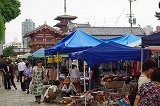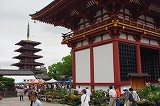Let’s Go Browse at an Antique Market!
Japan has many antique markets that operate on the grounds of temples and shrines, usually on special days on the calendar or during festivals. Located apart from stalls selling walk-away snack foods, professional vendors of antiques or individual collectors arrange merchandise for sale. Unlike flea markets in which used clothing or various old objects are sold by amateurs, the antique markets in Japan offer a variety of traditional handicrafts and objets d’art, and can be enjoyed just for the view alone. Here, we’d like to introduce four of Japan’s regularly held markets, two in Tokyo and one each in Kyoto and Osaka.
<Shitenno-ji temple, Osaka>
At this huge temple, the 21st day of each month is observed as “Daishi-e,” the date the Buddhist saint Kobo Daishi (774-835), also known as Kukai, passed away. The 22nd is observed as “Taishi-e,” the date Prince Shotoku (574-622), a political leader and ardent proponent of Buddhism, of passed away. On these two days, some 300 vendors set up shop on the temple grounds. In addition to snack foods and items of daily use, antique items are sold. The five-story pagoda and other buildings on the temple grounds are open to the public for free.
Location of Shitenno-ji temple: five minutes’ walk from Osaka’s JR Shitenno-ji station
Operating dates: 21st & 22nd of each month
Hours: 8:30 ~ 16:00
Number of stalls: approx. 300
URL: http://www.shitennoji.or.jp (in Japanese only)
<Kitano-Tenmangu, Kyoto>
This Shinto shrine, located north of the Kyoto central station, enshrines a prominent scholar and statesman, Sugawara Michizane (845-903). On the 25th day of each month, which coincides with the day Sugawara passed away, many worshippers and tourists visit the shrine. As Kyoto has the highest population of students relative to its overall population, many people come to write prayers on ema (votive tablets), or to pray for success at school entrance examinations. The many goods arranged for sale at these markets are characteristic of Kyoto and are quite appealing.
Location of Kitano-Tenmangu: 15 minutes’ walk from JR Enmachi station
Operating dates: 25th of each month
Hours: 6:00 ~ 16:00
Number of stalls: approx. 300
URL: http://kitanotenmangu.or.jp/english/
<Oedo Antique Market, Tokyo>
This antique market was organized from 2003, to commemorate the 300th anniversary of the designation of Edo (present-day Tokyo) as the capital of Japan’s Tokugawa dynasty. Located conveniently just minutes away from the famous Ginza shopping district, the market also offers western antiques, paintings and many other types of goods. It attracts large numbers of foreign visitors, and many of the vendors are able to communicate in English.
Location of Oedo Antique Market: Outside Tokyo International Forum, close to JR Yurakucho station
Operating dates: 1st and 3rd Sunday of each month (subject to change, please check dates on the Web site)
Hours: 9:00 ~ 16:00
Number of stalls: approx. 250
URL: http://antique-market.jp/eng/
<Tomioka Hachmangu Antique Market, Tokyo>
Here can be found over 140 stalls offering ceramics, Buddhist icons, toys and other items. Some shops sell swords, firearms armor, helmets, etc., which are registered as authentic antiques, and in order to take them out of Japan, application must be submitted to a prefectural board of education and a waiver obtained. As such permits may require one week or longer, tourists on a short visit will probably have to content themselves merely by seeing and touching the goods.
Location of Tomioka Hachmangu Antique Market: a three-minute walk from Monzen Nakacho subway station (Tozai Line).
Operating dates: 1st and 2nd Sunday of each month
Hours: 6:00 ~ 17:00
Number of stalls: approx. 140
URL: http://www.tomiokahachimangu.or.jp/ (in Japanese only)






